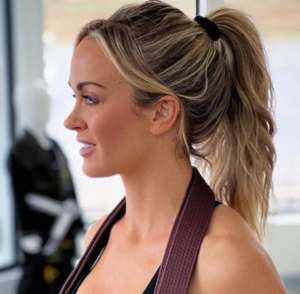Laura Sanko explains the UFC’s Grounded Opponent rule and possible changes and promotions
#Laura #Sanko #explains #UFCs #Grounded #Opponent #rule #promotions
Welcome to Allsocial Updates . Get latest News related to entertainment, Education, Technology, Sports, Science , Finance at one place. Please Subscribe to our feed and Bookmark our website for all updates around the world
Laura Sanko: Benefits of the rule change
The UFC rules for downed opponents have long been the subject of debate and discussion.
The current regulations are designed to ensure the safety of fighters while maintaining an exciting and competitive environment.
However, a recent development suggests that these rules may be subject to significant change.
The Association of Boxing Commissions and Combat Sports (ABC) is set to vote on a possible revision of the grounded fighter rule that could dramatically change the way fighters approach grappling and slugfests.
The current rule: an overview
Currently, the UFC’s downed opponent rule prohibits fighters from executing knee strikes to the head of an opponent who is considered down.
According to the UFC, the definition of a downed fighter includes any fighter who touches the mat with at least one knee or hand.
The aim of this rule is to protect the fighters from possible injuries and to ensure fairness in fights on the ground.
On July 24The ABC will vote on a proposed revision of this rule.
The possible change as shown by UFC commentator Laura Sanko during the UFC Vegas 94 eventKnee strikes to the head of a grounded opponent would be legal if only one hand touches the mat and provided the fighter has another part of the body (such as a knee, shin, or butt) also touching the ground.


Effects on grappling dynamics
This proposed change is expected to significantly impact the dynamics of grappling matches. Under the current rule, fighters can use the “hands down” position to avoid legal knee strikes to the head.
This creates a gap that some fighters exploit strategically. The proposed change would close that gap, potentially making fighters more cautious when placing a hand on the mat.
Increased activity and aggressiveness
One of the most notable benefits of the proposed rule change is the potential increase in activity and aggressiveness in grappling matches.
Fearing a legal knee to the head, fighters may be less inclined to place a hand on the mat. This could lead to a more dynamic and fluid wrestling match where fighters try to get better positions and not give their opponents opportunities to strike.
Faster completion
The revised rule could also result in fights being ended more quickly. By threatening a legal knee strike, fighters would be more likely to take advantage of opportunities and chances, which could lead to quicker results in wrestling matches.
This change could contribute to a more exciting and fast-paced atmosphere in the Octagon.


Laura Sanko: Possible disadvantages of the rule change
Increased risk of injury
One of the biggest concerns about the proposed rule change is the potentially increased risk of injury.
Knee strikes to the head can be particularly dangerous and, if allowed under the revised rules, could lead to a higher number of head injuries.
This could raise concerns about the safety of fighters and the long-term health consequences of such attacks.
Adaptation and strategy
Fighters and coaches will need to adapt their strategies to the revised rules. This could include changes in training and match planning to account for the increased risk of knee strikes.
While some fighters may excel under the new rules, others may struggle to adapt, leading to an adjustment period within the sport.
Reactions from fighters and trainers
The proposed rule change has drawn mixed reactions from fighters and coaches. Some see it as a positive development and believe it will lead to a more exciting and active sport. Others are concerned about the potential risks and the need to adapt strategies and training methods.
Fighters who prefer a fast and aggressive style will likely welcome the change as it could benefit their strengths.
The increased risk of knee strikes could also encourage fighters to refine their grappling skills and focus on maintaining advantageous positions.
Laura Sanko: Promotion
Laura Sanko promoted the snack product Beef Sticks on her Instagram account and then included a link to a discount in her bio.
Concerns and criticism
On the other hand, some fighters and coaches express concerns about the possible increase in injuries and the impact on the safety of fighters.
The revised rule could lead to an increased risk of head injuries and some argue that it could shift the balance of power in grappling matches.
The UFC has revised its rules many times to improve safety and maintain the integrity of the sport. Previous changes have included adjustments to weight classes, striking rules and fouls. Each rule change has aimed to address specific issues and improve the overall experience for fighters and fans alike.
The role of the Association of Boxing Commissions and Combat Sports
The Association of Boxing Commissions and Combat Sports (ABC) plays a crucial role in regulating and overseeing combat sports, and its decisions influence how the rules are applied and enforced across various federations, including the UFC.
The upcoming vote on the Grounded Opposition Rule is an example of how the ABC is working to ensure the rules evolve in response to changing dynamics and safety concerns.
As ABC prepares to vote on the proposed rule change, there is much anticipation and speculation in the UFC community.
If the revision is approved, fighters, coaches and fans will have to get used to the new regulations. The impact of the change will become more apparent once it is implemented and it will be interesting to see how it affects the sport in the long term.
